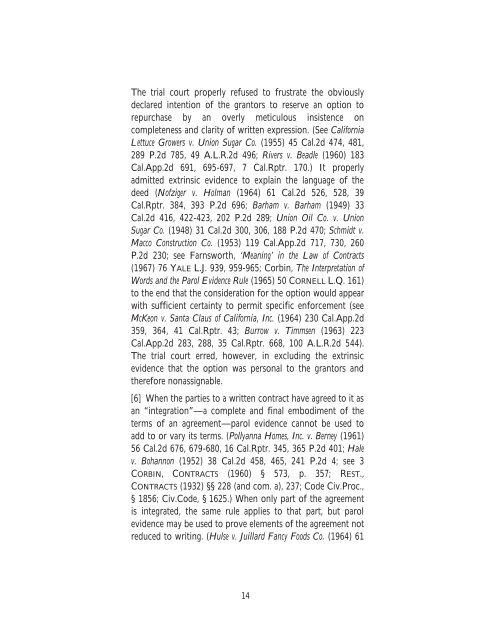Contract Doctrine, Theory & Practice Volume 3, 2012a
Contract Doctrine, Theory & Practice Volume 3, 2012a
Contract Doctrine, Theory & Practice Volume 3, 2012a
Create successful ePaper yourself
Turn your PDF publications into a flip-book with our unique Google optimized e-Paper software.
The trial court properly refused to frustrate the obviously<br />
declared intention of the grantors to reserve an option to<br />
repurchase by an overly meticulous insistence on<br />
completeness and clarity of written expression. (See California<br />
Lettuce Growers v. Union Sugar Co. (1955) 45 Cal.2d 474, 481,<br />
289 P.2d 785, 49 A.L.R.2d 496; Rivers v. Beadle (1960) 183<br />
Cal.App.2d 691, 695-697, 7 Cal.Rptr. 170.) It properly<br />
admitted extrinsic evidence to explain the language of the<br />
deed (Nofziger v. Holman (1964) 61 Cal.2d 526, 528, 39<br />
Cal.Rptr. 384, 393 P.2d 696; Barham v. Barham (1949) 33<br />
Cal.2d 416, 422-423, 202 P.2d 289; Union Oil Co. v. Union<br />
Sugar Co. (1948) 31 Cal.2d 300, 306, 188 P.2d 470; Schmidt v.<br />
Macco Construction Co. (1953) 119 Cal.App.2d 717, 730, 260<br />
P.2d 230; see Farnsworth, ‘Meaning’ in the Law of <strong>Contract</strong>s<br />
(1967) 76 YALE L.J. 939, 959-965; Corbin, The Interpretation of<br />
Words and the Parol Evidence Rule (1965) 50 CORNELL L.Q. 161)<br />
to the end that the consideration for the option would appear<br />
with sufficient certainty to permit specific enforcement (see<br />
McKeon v. Santa Claus of California, Inc. (1964) 230 Cal.App.2d<br />
359, 364, 41 Cal.Rptr. 43; Burrow v. Timmsen (1963) 223<br />
Cal.App.2d 283, 288, 35 Cal.Rptr. 668, 100 A.L.R.2d 544).<br />
The trial court erred, however, in excluding the extrinsic<br />
evidence that the option was personal to the grantors and<br />
therefore nonassignable.<br />
[6] When the parties to a written contract have agreed to it as<br />
an “integration”—a complete and final embodiment of the<br />
terms of an agreement—parol evidence cannot be used to<br />
add to or vary its terms. (Pollyanna Homes, Inc. v. Berney (1961)<br />
56 Cal.2d 676, 679-680, 16 Cal.Rptr. 345, 365 P.2d 401; Hale<br />
v. Bohannon (1952) 38 Cal.2d 458, 465, 241 P.2d 4; see 3<br />
CORBIN, CONTRACTS (1960) § 573, p. 357; REST.,<br />
CONTRACTS (1932) §§ 228 (and com. a), 237; Code Civ.Proc.,<br />
§ 1856; Civ.Code, § 1625.) When only part of the agreement<br />
is integrated, the same rule applies to that part, but parol<br />
evidence may be used to prove elements of the agreement not<br />
reduced to writing. (Hulse v. Juillard Fancy Foods Co. (1964) 61<br />
14


















